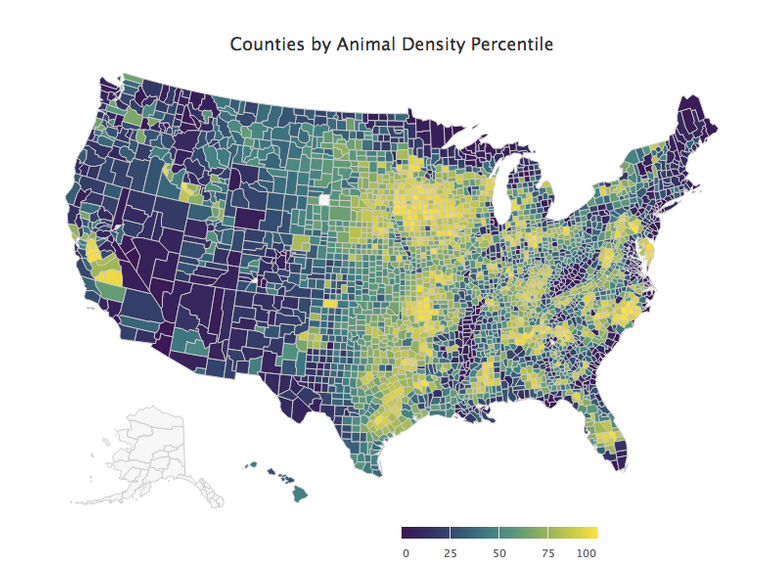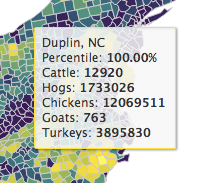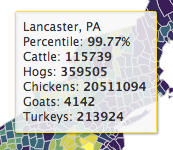This interactive map lets you investigate where animals are in the United States. I regularly analyze data in animal agriculture, with interests in the rise of factory farming of hogs and cattle, the waste this industry creates, and the burdens faced by people impacted by it. This map will let people explore some data for themselves.
The 2012 USDA Census of Agriculture contains county-level livestock head counts for several different types of animals. This census also records how much each type of animal weighs. US counties are extremely varied in size, and so are their animals. In 2012 the average American chicken weighed 6 pounds while the average cow weighed 1249.
In each county, the head count of each animal is multiplied by that animal's average weight, creating an estimate for the total amount of pounds of that animal in that county. Cattle, hogs, chickens, goats, ducks, and turkeys are counted in this map. All county animal weight totals are summed, and this total weight is divided to yield an estimate for pounds of animal per square mile for each county. This number is scaled by percentile and used to color code the map:

Data from 2012 USDA Census of Agriculture. Yellow counties have the greatest animal mass per area, while the purple counties have the least.
An interactive version of this map is available (it may load slowly). There are some missing counties, and it seems that a technical issue left out data on Alaska entirely. On the interactive map, hovering over an individual county will show its their livestock counts:

It was not surprising to see Duplin, NC rank at the top of this metric, because Duplin's hog industry is well known for reckless pollution that harms the health of the disproportionately poor, non-white county. Duplin was also the focus of a previous article and a visualization I posted that discusses the strong presence of animal agriculture pollution in low income communities.

This data can also be revealing about random counties as well. For instance, Lancaster, PA had over 20 million chickens in 2012. It's not surprising that this county has had its own issues with waste pollution as well.
If you find anything interesting on this map, please comment!
All code used to process data and create graphs is on GitHub.

Hi @somethingburger, thanks for sharing your agricultural research and for publishing your data!
In an effort to make your content more visible and engage a broader range of audiences here - you might want to consider using the #steemstem tag to tap the shoulder of @steemstem (a scientific community here that curates content like this.)
curation guidelines, here.There's also @utopian-io. They curate open source projects much like this one if you use their tag #utopian-io (as a primary tag) and #____ depending on what category this falls under. Learn more about their
In addition to what @sndbox just said, keep in mind that @steemstem only curates posts that are over 1000 words (which this one isnt) and those that are structured. Therefore if you want to be eligible for their upvotes make sure to have at least 3 paragraphs, where one will introduce the whole article and one will summarize it.
I myself failed to receive upvotes from them for my thesis articles, since they do not meet the required format, but you will know better then I did back then:).
Hi @fingersik. I just want to correct something regarding the words count. Actually, there is no such requirement. The author can write as much or as simple as they would like to and still be curated. Apart from that, things like a minimum of 500 words or a specific number of paragraphs are just some guidelines to help newbies to structure their own article. Although people were less likely to receive a vote from steemstem if their article is too short but if it is good, then it would be curated.
Write your article as creative as you can, cite your article's references and images' sources and you are good to go. If you were not curated it can be due to a few reasons but writing less than 1000 words is not one of them.
Thanks for the clarification! The information i provided was given by different Steemstem mentor. I’m glad you corrected me...in that case my articles clearly sucked:D
Thank you @fingersik! This is good to know.
Thanks @sndbox! I've adjusted the tags and will continue to open my work up to more curators.
You are always welcome to join us and get more recognition for your posts. You can find more information about geopolis here or join our Discord server.